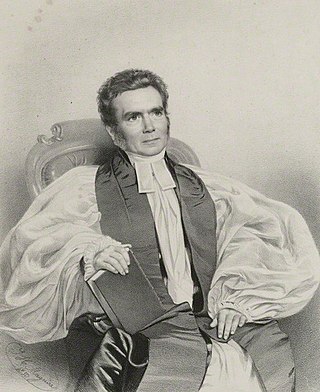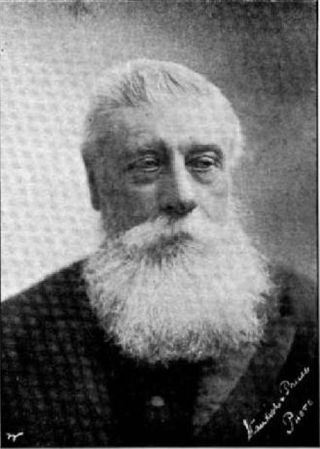
The Waimakariri River is one of the largest rivers in Canterbury, on the eastern coast of New Zealand's South Island. It flows for 151 kilometres (94 mi) in a generally southeastward direction from the Southern Alps across the Canterbury Plains to the Pacific Ocean.

The Ōpāwaho / Heathcote River lies within the city boundaries of Christchurch, New Zealand, and is fed from springs near Templeton Road, with a catchment area in wet weather extending as far west as Yaldhurst and Pound Road. It meanders around the base of the Port Hills from west to south-east.
The 2nd New Zealand Parliament was a term of the Parliament of New Zealand. It opened on 15 April 1856, following New Zealand's 1855 election. It was dissolved on 5 November 1860 in preparation for 1860–61 election. The 2nd Parliament was the first under which New Zealand had responsible government, meaning that unlike previously, the Cabinet was chosen by Parliament rather than by the Governor-General of New Zealand.
Selwyn is a village in the Selwyn District of Canterbury, New Zealand. It was laid out in the 1860s for a population of 2,000 people, but it currently has very few houses.

Oxford is a small town serving the farming community of North Canterbury, New Zealand. It is part of the Waimakariri District and is a linear town, approximately 2 kilometres (1.2 mi) long. Oxford has won awards for the most beautiful village and the most beautiful toilet.

Sheffield is a small village located in the Selwyn District of the Canterbury region of New Zealand's South Island, near the Waimakariri Gorge.
Papanui is a former New Zealand parliamentary electorate. The electorate was in the northern suburbs of the city of Christchurch, and existed from 1969 to 1984.
Omata was a New Zealand electorate. It was located in Taranaki and based on the township of Omata. One of the original 24 electorates, it existed from 1853 to 1870.
Wairarapa and Hawke's Bay is a former parliamentary electorate in the Wellington region of New Zealand from 1853 to 1859, when it was extended into previously unincorporated territories, split in two, and replaced by the County of Hawke, with its southern portion being the newly created Wairarapa electorate. It is the first general electorate to have been abolished in New Zealand.

Samuel Hinds, was a British clergyman. He was appointed Bishop of Norwich in 1849 and resigned in 1857. Hinds was of the Broad Church in his views. He had strong links with the Ngati Kuri (Wai262) and Te Patu tribes of New Zealand, noting a paramount Maori chief Rata Ngaromotu of Ngati Kahu and the colonisation of New Zealand and the town of Hinds, New Zealand is named after him.
Lincoln was a parliamentary electorate in the Canterbury region of New Zealand from 1881 to 1890. It was represented by two Members of Parliament.

Courtenay was a parliamentary electorate in Canterbury, New Zealand from 1902 to 1908. The electorate was represented by one Member of Parliament, Charles Lewis.
Ellesmere was a parliamentary electorate in the Canterbury region of New Zealand. It existed for two periods between 1861 and 1928 and was represented by six Members of Parliament.
Northern Division was a two-member parliamentary electorate in the Auckland Region, New Zealand from 1853 to 1870.

Andrew Duncan was Mayor of Christchurch 1869–1870. From a working-class background in Scotland, he emigrated to New Zealand as a young man and became a highly respected member of the Christchurch community. He is remembered for his later work as an immigration agent in Scotland on behalf of the Canterbury Province.

Henry Richard Webb JP FRMS was a New Zealand businessman and politician. He represented Lyttelton in Parliament for 2½ years and was a supporter of education in his later years. Born in Australia, he came to Canterbury in 1868.

State Highway 73 is a major east-west South Island state highway in New Zealand connecting Christchurch on the east coast with Cass/Hokitika via the Southern Alps. It is mostly two lane, with some single-lane bridges north of Springfield but is mostly dual carriageway in Christchurch. The fourth and fifth-highest points of New Zealand's state highway network are on this road at Porters Pass and Arthur's Pass respectively.

William Guise Brittan, mostly known as Guise Brittan and commonly referred to as W. G. Brittan, was the first Commissioner of Crown Lands for Canterbury in New Zealand.

Captain Joseph Thomas (1803–?) was a British explorer and the chief surveyor for Lyttelton, Sumner and Christchurch in New Zealand. He took up surveying after service in the British army, gaining the rank of lieutenant. In the 1840s, he explored many parts of New Zealand and worked for the New Zealand Company. This gained him employment with the Canterbury Association, which sent him to New Zealand in 1848. Thomas' role was to find a suitable site for their proposed settlement, and what became the Canterbury region with Christchurch as its capital was the result of his efforts. He was dismissed in early 1851 over quarrels with John Robert Godley, the agent of the Canterbury Association, just after the first settlers had arrived in the colony. Thomas' life after 1853 is unknown. Having allowed for Hagley Park as a generous central city green space is regarded as his major achievement, and it is his lasting legacy.
Marmaduke Dixon was an early settler in North Canterbury, New Zealand. He went to sea early in his life before he settled on the north bank of the Waimakariri River. An innovative farmer, he chaired a number of road boards and was a member of the Canterbury Provincial Council.













